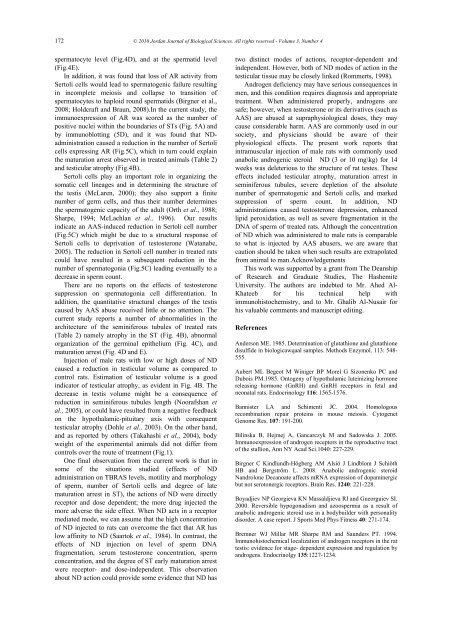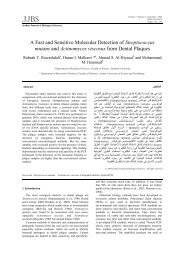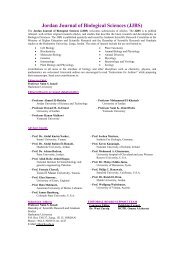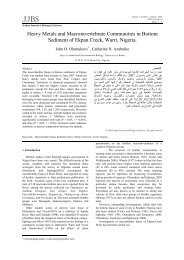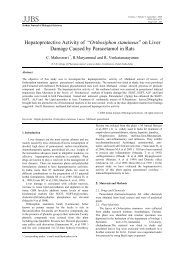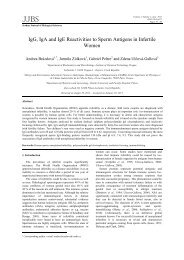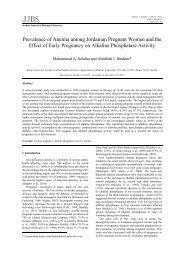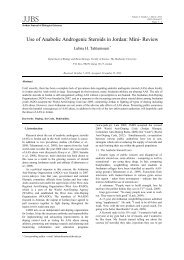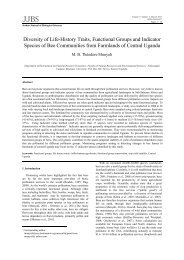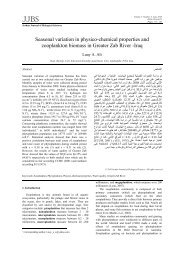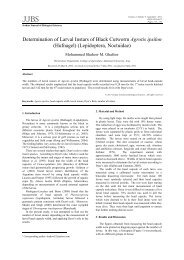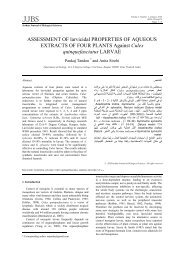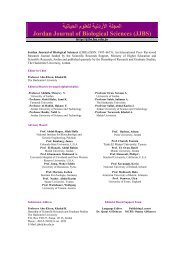Number 4 - Jordan Journal of Biological Sciences
Number 4 - Jordan Journal of Biological Sciences
Number 4 - Jordan Journal of Biological Sciences
You also want an ePaper? Increase the reach of your titles
YUMPU automatically turns print PDFs into web optimized ePapers that Google loves.
172<br />
© 2010 <strong>Jordan</strong> <strong>Journal</strong> <strong>of</strong> <strong>Biological</strong> <strong>Sciences</strong>. All rights reserved - Volume 3, <strong>Number</strong> 4<br />
spermatocyte level (Fig.4D), and at the spermatid level<br />
(Fig.4E).<br />
In addition, it was found that loss <strong>of</strong> AR activity from<br />
Sertoli cells would lead to spermatogenic failure resulting<br />
in incomplete meiosis and collapse to transition <strong>of</strong><br />
spermatocytes to haploid round spermatids (Birgner et al.,<br />
2008; Holdcraft and Braun, 2008).In the current study, the<br />
immunoexpression <strong>of</strong> AR was scored as the number <strong>of</strong><br />
positive nuclei within the boundaries <strong>of</strong> STs (Fig. 5A) and<br />
by immunoblotting (5D), and it was found that NDadministration<br />
caused a reduction in the number <strong>of</strong> Sertoli<br />
cells expressing AR (Fig.5C), which in turn could explain<br />
the maturation arrest observed in treated animals (Table 2)<br />
and testicular atrophy (Fig.4B).<br />
Sertoli cells play an important role in organizing the<br />
somatic cell lineages and in determining the structure <strong>of</strong><br />
the testis (McLaren, 2000); they also support a finite<br />
number <strong>of</strong> germ cells, and thus their number determines<br />
the spermatogenic capacity <strong>of</strong> the adult (Orth et al., 1988;<br />
Sharpe, 1994; McLachlan et al., 1996). Our results<br />
indicate an AAS-induced reduction in Sertoli cell number<br />
(Fig.5C) which might be due to a structural response <strong>of</strong><br />
Sertoli cells to deprivation <strong>of</strong> testosterone (Watanabe,<br />
2005). The reduction in Sertoli cell number in treated rats<br />
could have resulted in a subsequent reduction in the<br />
number <strong>of</strong> spermatogonia (Fig.5C) leading eventually to a<br />
decrease in sperm count.<br />
There are no reports on the effects <strong>of</strong> testosterone<br />
suppression on spermatogonia cell differentiation. In<br />
addition, the quantitative structural changes <strong>of</strong> the testis<br />
caused by AAS abuse received little or no attention. The<br />
current study reports a number <strong>of</strong> abnormalities in the<br />
architecture <strong>of</strong> the seminiferous tubules <strong>of</strong> treated rats<br />
(Table 2) namely atrophy in the ST (Fig. 4B), abnormal<br />
organization <strong>of</strong> the germinal epithelium (Fig. 4C), and<br />
maturation arrest (Fig. 4D and E).<br />
Injection <strong>of</strong> male rats with low or high doses <strong>of</strong> ND<br />
caused a reduction in testicular volume as compared to<br />
control rats. Estimation <strong>of</strong> testicular volume is a good<br />
indicator <strong>of</strong> testicular atrophy, as evident in Fig. 4B. The<br />
decrease in testis volume might be a consequence <strong>of</strong><br />
reduction in seminiferous tubules length (Noorafshan et<br />
al., 2005), or could have resulted from a negative feedback<br />
on the hypothalamic-pituitary axis with consequent<br />
testicular atrophy (Dohle et al., 2003). On the other hand,<br />
and as reported by others (Takahashi et al., 2004), body<br />
weight <strong>of</strong> the experimental animals did not differ from<br />
controls over the route <strong>of</strong> treatment (Fig.1).<br />
One final observation from the current work is that in<br />
some <strong>of</strong> the situations studied (effects <strong>of</strong> ND<br />
administration on TBRAS levels, motility and morphology<br />
<strong>of</strong> sperm, number <strong>of</strong> Sertoli cells and degree <strong>of</strong> late<br />
maturation arrest in ST), the actions <strong>of</strong> ND were directly<br />
receptor and dose dependent; the more drug injected the<br />
more adverse the side effect. When ND acts in a receptor<br />
mediated mode, we can assume that the high concentration<br />
<strong>of</strong> ND injected to rats can overcome the fact that AR has<br />
low affinity to ND (Saartok et al., 1984). In contrast, the<br />
effects <strong>of</strong> ND injection on level <strong>of</strong> sperm DNA<br />
fragmentation, serum testosterone concentration, sperm<br />
concentration, and the degree <strong>of</strong> ST early maturation arrest<br />
were receptor- and dose-independent. This observation<br />
about ND action could provide some evidence that ND has<br />
two distinct modes <strong>of</strong> actions, receptor-dependent and<br />
independent. However, both <strong>of</strong> ND modes <strong>of</strong> action in the<br />
testicular tissue may be closely linked (Rommerts, 1998).<br />
Androgen deficiency may have serious consequences in<br />
men, and this condition requires diagnosis and appropriate<br />
treatment. When administered properly, androgens are<br />
safe; however, when testosterone or its derivatives (such as<br />
AAS) are abused at supraphysiological doses, they may<br />
cause considerable harm. AAS are commonly used in our<br />
society, and physicians should be aware <strong>of</strong> their<br />
physiological effects. The present work reports that<br />
intramuscular injection <strong>of</strong> male rats with commonly used<br />
anabolic androgenic steroid ND (3 or 10 mg\kg) for 14<br />
weeks was deleterious to the structure <strong>of</strong> rat testes. These<br />
effects included testicular atrophy, maturation arrest in<br />
seminiferous tubules, severe depletion <strong>of</strong> the absolute<br />
number <strong>of</strong> spermatogenic and Sertoli cells, and marked<br />
suppression <strong>of</strong> sperm count. In addition, ND<br />
administrations caused testosterone depression, enhanced<br />
lipid peroxidation, as well as severe fragmentation in the<br />
DNA <strong>of</strong> sperm <strong>of</strong> treated rats. Although the concentration<br />
<strong>of</strong> ND which was administered to male rats is comparable<br />
to what is injected by AAS abusers, we are aware that<br />
caution should be taken when such results are extrapolated<br />
from animal to man.Acknowledgements<br />
This work was supported by a grant from The Deanship<br />
<strong>of</strong> Research and Graduate Studies, The Hashemite<br />
University. The authors are indebted to Mr. Ahed Al-<br />
Khateeb for his technical help with<br />
immunohistochemistry, and to Mr. Ghalib Al-Nusair for<br />
his valuable comments and manuscript editing.<br />
References<br />
Anderson ME. 1985. Determination <strong>of</strong> glutathione and glutathione<br />
disulfide in biologicawqaal samples. Methods Enzymol. 113: 548-<br />
555.<br />
Aubert ML Begeot M Winiger BP Morel G Sizonenko PC and<br />
Dubois PM.1985. Ontogeny <strong>of</strong> hypothalamic luteinizing hormone<br />
releasing hormone (GnRH) and GnRH receptors in fetal and<br />
neonatal rats. Endocrinology 116: 1565-1576.<br />
Bannister LA and Schimenti JC. 2004. Homologous<br />
recombination repair proteins in mouse meiosis. Cytogenet<br />
Genome Res. 107: 191-200.<br />
Bilinska B, Hejmej A, Gancarczyk M and Sadowska J. 2005.<br />
Immunoexpression <strong>of</strong> androgen receptors in the reproductive tract<br />
<strong>of</strong> the stallion, Ann NY Acad Sci.1040: 227-229.<br />
Birgner C Kindlundh-Högberg AM Alsiö J Lindblom J Schiöth<br />
HB and Bergström L. 2008. Anabolic androgenic steroid<br />
Nandrolone Decanoate affects mRNA expression <strong>of</strong> dopaminergic<br />
but not serotonergic receptors. Brain Res. 1240: 221-228.<br />
Boyadjiev NP Georgieva KN Massaldjieva RI and Gueorguiev SI.<br />
2000. Reversible hypogonadism and azoospermia as a result <strong>of</strong><br />
anabolic androgenic steroid use in a bodybuilder with personality<br />
disorder. A case report. J Sports Med Phys Fitness 40: 271-174.<br />
Bremner WJ Millar MR Sharpe RM and Saunders PT. 1994.<br />
Immunohistochemical localization <strong>of</strong> androgen receptors in the rat<br />
testis: evidence for stage- dependent expression and regulation by<br />
androgens. Endocrinolgy 135:1227-1234.


